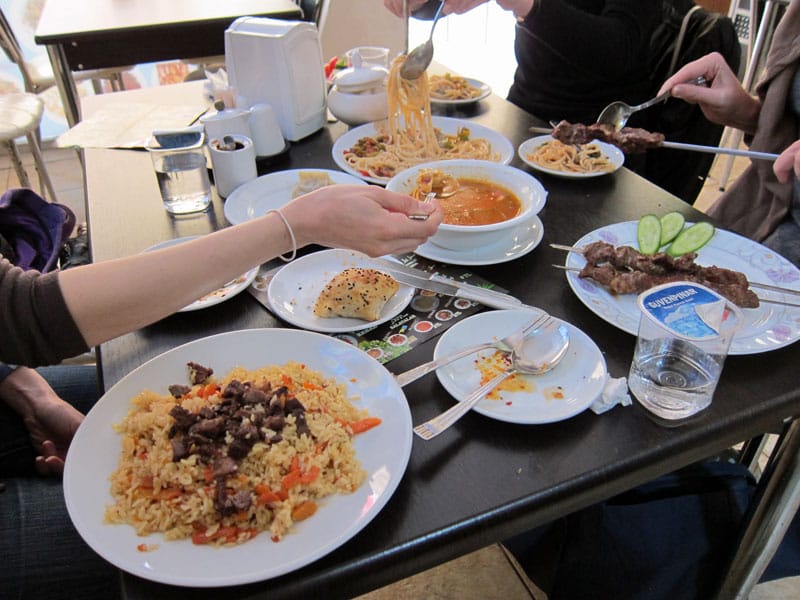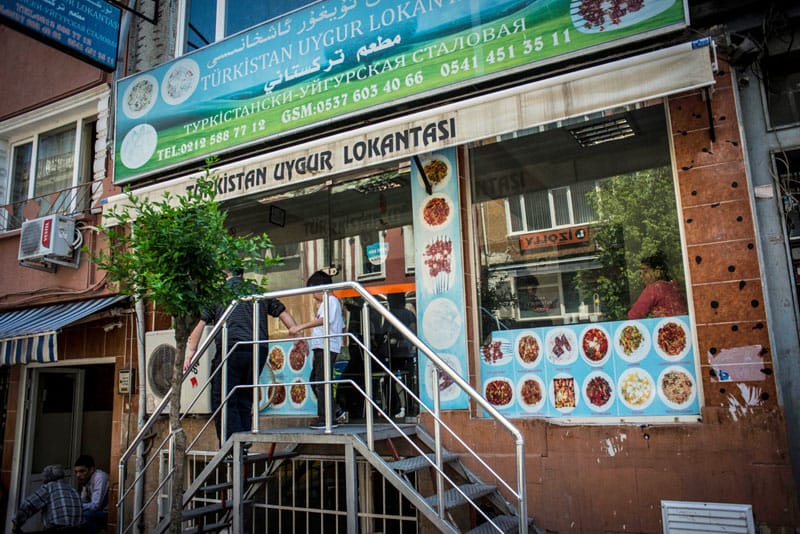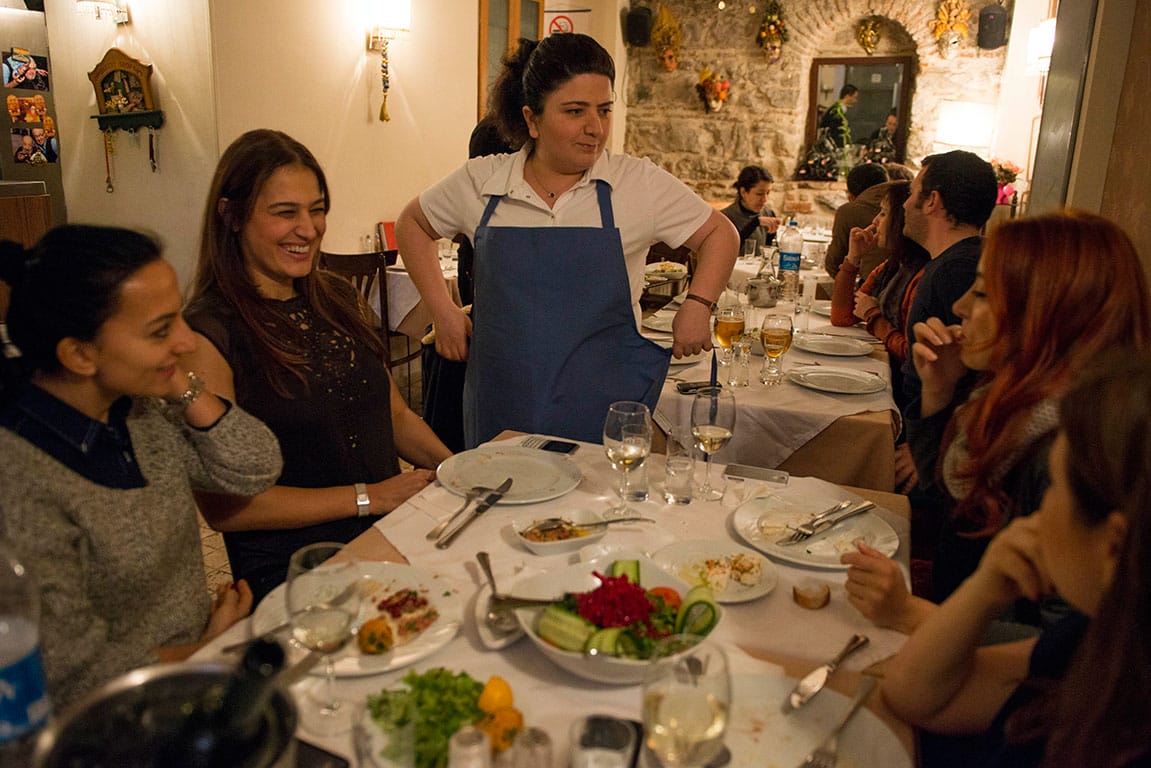Update: This spot is sadly no longer open.
Anyone who has spent time in the former Soviet republics of Central Asia (or, “the ’Stans”) will have developed a deep and lasting appreciation for the cuisine of the Uighur, a Turkic people spread across the region whose homeland, Uygurstan, lies across the border in western China. In Dushanbe, faced with the prospect of another oily pile of plov, Central Asian people and visiting foreigners alike gleefully opt for Uighur (romanizations vary) cuisine, whose hand-pulled, bouncy noodles, lagman, are ever-present from Shimkent to Khujand, yet still exotic.
We’ve chronicled the Uighur scene in Istanbul’s Zeytinburnu, where excellent lagman is to be found, but sometimes this neighborhood, in the city’s south, feels as distant as the Kashgar oasis itself.
Suffering from a serious lagman deficiency last summer, we took a casual meander around the backstreets near the Caucasus-bound bus station of Aksaray that turned into a moment of important discovery. The writing was right there on a leather-bound menu perched in the window: Lezzetli Uygur Yemekleri. We’d found Turkistan Uygur Lokantası and its simple yet enticing promise of “Delicious Uighur Food.”

The lunch-rush crowd here looked largely Uighur, and they were all greeted with a generous salam by the owner Ubeydullah, whose long beard brushed the keys of the cash register as he bowed slightly in greeting. Ubeydullah owns two other Uighur restaurants in Istanbul, making him the foremost Uighur restaurateur in town.
A shy, young Uighur waiter explained nearly every dish on the menu in the following terms: “It’s like the Turkish one [that it bears striking similarity to], but different.” Kazan kebab? Lamb skewers? Chicken sote? All quite different indeed, we’d found on previous visits, but not the dishes we’d cross town for. We didn’t need him to guide us toward the two-page spread of lagman varieties while we munched on somsa, a crunchy dough shell speckled with sesame seeds and stuffed with a steamy stew of lamb and onions.
From the lagman-related dishes we had suyak as, a lamb and dumpling soup composed of murky, meaty stock with thin dough squares, bits of lamb and shreds of spinach and chopped red bell peppers. Aci lagman kormasi is nearly the exact same ingredients stir-fried with soft half-inch cuts of lagman noodles, a spare, thickened sauce in place of the broth.
The lagman spesiyal is the connoisseur’s choice, in which a bowl of plain noodles is served beside a separate bowl of the topping, once again made of the previously encountered materials. The topping here is a pleasing counterpoint of tender slow-cooked meat and surprisingly lively, less-cooked vegetables sitting in a peppery gravy, but lagman is all about the noodles. Approaching the bowl of unadorned noodles, it’s hard not to see what the fuss is about.

We piled a few coils of beautifully irregular lagman on the topping. When held up with a fork they looked like a satellite photo of the Amu Derya river – all swells, narrows and bends. Spinning the lagman over the topping with a fork, Italian-style, produced the best results for us. The noodles came away fully sauced, wrapped around a nest of meat and peppers – a perfect bite. Heap or rake the topping over your noodles, or drag your noodles through the topping for just a slick of the spicy gravy – you can’t make a mistake with this dish. It is just as reliably satisfying here in Aksaray as diners surely recall it in Almaty or Karaganda. For people in this part of Aksaray who are not initiated in the ways of the Uighur kitchen, Vera Café, a Russian restaurant across the street, might be a tempting option, but let’s face it, everyone in this part of Aksaray knows better, even the Russians.
Editor’s Note: This article originally appeared on Istanbul Eats. You can read the original here.
 July 24, 2019 Totò Eduardo E Pasta E Fagioli
July 24, 2019 Totò Eduardo E Pasta E Fagioli
The Neapolitan stairs are ancient urban routes that connect the upper city (the Vomero […] Posted in Naples December 11, 2015 Mari
December 11, 2015 Mari
Editor's note: We regret to report that Mari, which was run by the former chef and […] Posted in Istanbul November 8, 2013 Taverna Can Roca
November 8, 2013 Taverna Can Roca
Editor’s note: We regret to report that Taverna Can Roca has closed.
In the […] Posted in Barcelona
Published on June 13, 2014
Related stories
July 24, 2019
NaplesThe Neapolitan stairs are ancient urban routes that connect the upper city (the Vomero district) to the lower city (the historic center). The most famous of these stairs is the Pedamentina di San Martino, a staircase of 414 steps dating back to the 14th century, which starts from the old center and reaches the Castel…
December 11, 2015
IstanbulEditor's note: We regret to report that Mari, which was run by the former chef and owners of Mekan, has now closed Check out our review of her latest tasty venture, Marinee Kaburga, here. In the great multicultural Anatolian kitchen, questions about the ethnic or national origins of foods are often cause for forks and…
November 8, 2013
Barcelona | By Claire Gledhill
BarcelonaEditor’s note: We regret to report that Taverna Can Roca has closed. In the neighborhood of Sant Andreu we encounter very few city visitors wandering the cobbled streets or peering at the 19th-century two-story houses that pepper this district. Through the doors of Taverna Can Roca, we find even fewer. This is a place that…


















































































